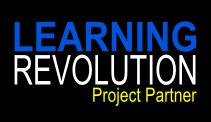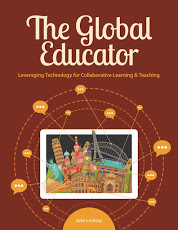Drew Murphy
Sechelt, British Columbia, Canada
Blog: http://ddddmurphy.edublogs.org/
Bio
Drew Murphy is a technology/business teacher at Chatelech Secondary and lives in the beautiful seaside town of Gibsons, in British Columbia. He teaches and manages an in-school online program called Planning 10 and Portfolio. In this program he has been developing innovative online teaching methods and applying a variety of 2.0 tools. He has been involved in pioneering online programs and methods in his district for the past 15 years. During this time, he has also been a educational consultant in designing online learning systems. He has a passion for teaching in the online world and believes it is a meduim that can bring art of teaching and the act of learning to a new level.
Bio Page
https://k12online07presenters.wikispaces.com/Drew+Murphy
Presentation Title
“Step by Step- Building a Web2.0 Classroom”
Description
Drew presents the 10 essential skills and concepts needed for playing the Web 2.0 game. He shows you an order of online activity types that flow into each other and builds your online teaching skill set so that you can apply Web 2.0 tools at the appropriate time and in the appropriate way. He also shows how to progressively apply a variety of methods and 2.0 tools so that people can see the fundamentals in action and understand the potential that exists to move forward. Finally, he’ll give you his insights daring predictions for the future of Web 2.0 and get you thinking in ways you probably would never have considered. And he’ll show that the road to the future lies along the path of fundamental skills and concepts.
Presentation
iPod ready
http://k12online.wm.edu/dmurphypart1.mp4 (40:00 Run Time, mpeg4, 47.1 MB)
http://k12online.wm.edu/dmurphypart2.mp4 (28:53 Run Time, mpeg4, 53 MB)
Original
http://k12online.wm.edu/dmurphypart1.mov (40:00 Run Time, mov, 628 MB)
http://k12online.wm.edu/dmurphypart2.mov (28:53 Run Time, mov, 417.6 MB)
Audio only
http://k12online.wm.edu/dmurphypart1.mp3 (40:00 Run Time, mp3, 9.21 MB)
http://k12online.wm.edu/dmurphypart2.mp3 (28:53 Run Time, mp3, 6.7 MB)
Supporting Links
Google Video
http://video.google.ca/videoplay?docid=-9132701495911891485
Production Tools
xspression project
http://support.schools.xspression.com
zoho.com
http://zoho.com/
tangler.co
http://tangler.com/
bubbleshare.com
http://bubbleshare.com/
viddler.com
https://viddler.com/
netvibes.com
http://netvibes.com/
What is “Take My Hand”?
“Take My Hand”
[tags]k12online07cl07, k12online07[/tags]








I am loving your video, however the download stops part way through.
This conference is wonderful! We already have ideas in motion.
Jacky
great presentation
very well laid out and easy to follow
good classroom application ideas
Jacky: The original part 1 video has this problem at the 22:06 point, and the compressed iPod version does too because it was based on that original. This may have happened during the file transfer process to the W&M server… We are re-uploading the file and recompressing, so it should be fixed later today. I will comment here when this is fixed, so people will know and can re-download the complete file.
Thanks for your comments Jacky and Tracie. While Wes and the team is re-uploading part 1, you could also click over to my blog ( http://ddddmurphy.edublogs.org )where I’ve got the videos posted with some summary information and other things.
Thanks for looking after that Wes!
ddddmurphy.edublogs.org
Both the iPod version and the original part 1 video linked here are now complete and do not pause after 20 minutes! You should be able to download and view the entire part 1 video now.
Great presentation. I thought that there were a number of great thoughts in there. Creating and building a web 2.0 classroom can be hard and frustrating at times, particualrly when you are trying to model and encourage other teachers to just begin using technology. I just gave a session on making newsletters with publisher. I know that the thought of web 2.0 would be too much.
Just being an educational technology teacher in a school is hard. So why do we keep doing it? The frustrating thing for me is knowing that when students leave my class they are going to be going back to the dark ages with the next teacher who hardly uses technology for themself let alone with the students.
I thought I would start a list of reasons why educational technology teachers continue to try technology in their class when others around them don’t understand and refuse to try. The list is on my blog at:
http://ihancock.edublogs.org/why-i-am-a-educational-technology-teacher/
Share it around and let’s build it up!
Thanks
Ian
You are a wild man, and I love this! You must teach middle school with your personality.
Thank you for your work! I have never seen web2.0 broken down so simply.
I have been working on a similar project with my
“A Teacher’s Tour Guide into the New Read/Write Web2.0 – 10 Part Series” at http://edvibes.com/welcome-to-the-web20-world-6-part-series/
I would love to get some of your feedback.
You mentioned you were using “expression project” to build your course page could give me the link to the application.
What a wonderful preso. Fast-paced, modeling the concepts being taught, logical, engaging, humorous, sequential, meaty but not too much so, wow. I sure learned a lot.
Alex, scroll up this page to “Supporting Links” and you’ll see a hotlink to the xspressions project
Hi Ian: Thanks for you comments. I empathize completely with your frustrations regarding other staff members not getting involved with technology. Its an interesting process actually. People like ourselves see technology enriching our teaching methods with relevance, media and communications. But I’m learning that’s not enough for most teachers or maybe its too much. Either way, technology isn’t giving most teachers what they’re looking for right now. There’s lots of veterans who’ve taught for many years and they do see technology as useful and effective but its still not worth all the time and effort. Of course, once you dig in to the web 2.0 processes you understand the huge potential that exists to make my job interesting and rewarding.
But I’m feeling that we are still in the early stages of the web learning revolution. I like blogs and wikis and all the cool web 2.0 tools but they aren’t the final answers for educators. They are still rather awkward to apply and integrate with kids and they don’t transform education but are still seen as add-ons by many teachers. I think we are still waiting for an application that transforms our jobs the way say, spreadsheets, transformed business. I think if technology can truly save teachers time and reduce our huge workloads then we’ll see wide spread adoption of technology and from there, more movements towards many of the great things we, the early adopters, are experiencing.
Hi Alice: Thanks, I’m glad you enjoyed the presentation. And yes I teach grades 10, 11, 12. I’ve been called other things besides a “wild man” too. It comes from the appeal I find in using the unique potential of the web for creating characters and story and weaving them into the teaching. As Vinnie says, “Just be the box.”
You’ll be featured on It’s Elementary 10/22 at 23:00 GMT http://www.edtechtalk.com/node/2398
Thanks for responding to my K12 presentation Alex. Your site is certainly more in depth and detailed. I browsed each part and found your level of detail very impressive. Part 1 was particularly interesting in its historical analysis of the web 2.0 development. The graphics were very useful to capture what is a actually a very abstract development process. Part 1 alone would have made a very informative presentation at the K12 conference.
If its fine with you, I’d like to link to this from my blog.
As you mentioned in your post at the k12 conference. I’ve been focusing on, what I consider the essential skills that let people “in” to the web 2.0 experience. For me, as I constantly work at bringing students and staff on board, its always a process of distilling the experience down to its basic elements and “boiling” off the extras to get at the core concepts. Comprehensive resources like yours are fantastic for people like me to help in the layering of developmental stages of web 2.0 adoption. I look forward to the other stages of your teacher’s guide. Stay in touch and let me know when its done.
Thanks
Drew
Thanks for this. I appreciate your ability to simplify many of these concepts and contextual them in terms of the web 2.0 world. I’ve struggled with beginning teachers and am often guilty of jumping in too quickly. This is good stuff. I’ll be using it in the future.
Your presentation was very concise
and easy to understand. Your 10 step plan can be easily implemented by virtually any teacher. Web 2.0 tools are a wonderful resource for any classroom. The online experience enhances any classroom instruction. You affirmed that just having basic
technology skills is all that is needed to enter the digital age.
Hello,
My name is Elvine from Pageflakes. I think it’s great that Drew has been educating students and teachers of the basic skills and concepts for understanding the Web 2.0 experience. In light of incorporating technology within the classroom, Pageflakes, in fact, has created a start page dedicated to teachers.
I would love to hear any feedback of the “Educational Start Page” that we recently launched — http://teacher.pageflakes.com. It is still a work in progress and your comments are more than welcome.
The “Teacher Edition” is based on the original Pageflakes technology, offering sharing and publishing options, adding your own content, customizing the page, changing the layout – all for free and even without signing up. In addition we have customized the gallery (click on the big, golden button at the upper right hand corner) and populated it with educational tools and news. We have also created a default page setup (the one that you see when you first check out the site).
There is more to come in the future and I am hoping that you can actively help us to improve the experience. Your questions, ideas and suggestions are more than welcome. I am happy to send more background information and screenshots. I am also available for a call if you want to discuss in more detail.
Thanks for your time and support.
With Best Regards,
Elvine
My Pagecast!
http://www.pageflakes.com/elvine
Pageflakes Inc.
http://www.pageflakes.com
Hi I found your video really helpful , to summarise for me practicval steps for teachers uisng and introducing Web 2.o. Thanks. Heather New Zealand
Great presentation, very informative and definatly taught me how to incorporate Web 2.0 in my classroom
very good presentation, learned a lot
Pingback: Reflection on Drew Murphy’s “Step by Step - Building a Web 2.0 Classroom” | Learning, Teaching & Technology
Pingback: Step by Step: Building a Web 2.0 Classroom By Drew Murphy « Darin Janssen’s Weblog
Pingback: Web 2.0 Learning Tools » Blog Archive » Thing “13″ Conference
Hi Drew,
I wanted to suggest a website I recently came across that might be a good place for teachers to collaborate with their students using web 2.0. FatClass (www.fatclass.com) is a web 2.0 facebook-like application specifically geared toward students and teachers. It is designed by educators and it allows teachers to create “fatclasses” around the classes they teach. Students can be added to the network and a class can communicate and collaborate using web 2.0 tools, such as blogs, file sharing and more.
I setup an account and started a fatclass for my AVID students. I hope to have some blogging on related college topics, as well as share important files when needed. We’ll see how it goes….just thought it might be helpful
Pingback: K12 Online “Step by Step- Building a Web2.0 Classroom” « Brooke Schofield
Pingback: Change List: "Be The Box" | Learning is Change